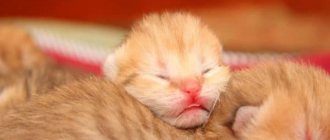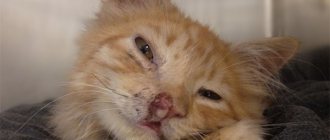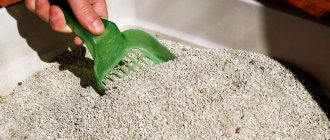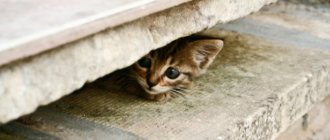The vital activity of an animal is not only nutrition and growth, but also reproduction. Every owner should know how cats give birth for the first time in order to help an inexperienced mother. Instinctively, the animal feels what needs to be done, but the pain makes the firstborns afraid and stressed. The owner’s ability to come to the rescue in time will help save the pet’s life.
Sterilize or deliver?
Of course, the most convenient way for the owner and the most humane way for the animal to solve the problem is sterilization. Having undergone a simple operation once, the cat will be free from natural urges and will be able to feel normal, living in the limited conditions of a city apartment. But for those who are going to let their pet outside, it will be much more convenient and less troublesome if the cat is sterilized. First of all, this will get rid of the crowds of fans who will definitely gather at certain times of the year in the yard and under the door. They can seriously fray your nerves both by staining all the walls and with their endless nightly serenades.
After sterilization, the cat will not produce kittens
But the most important advantage of sterilization is that the cat will no longer produce kittens. That is, its owner will not have to rack his brains about where to place the babies.
If the owner of the animal decided not to go against nature and refused sterilization, he should know what to do if the cat gives birth, because more than once he will have to watch how little kittens are born. As a rule, cats easily cope with this task without outside help, but sometimes childbirth can occur with complications. In this case, all hope lies only with the person who is obliged to help his pet. And if a cat gives birth for the first time, every owner should know what to do in this case.
Causes of problems
Taking a dip at home is quite easy. It doesn’t matter if it’s a village house or a city apartment. But in some cases, the pregnancy period has passed, and the cat still does not give birth, although all the signs are obvious. The kittens will continue to grow, taking away strength and energy. The larger the fetus, the more difficult the birth will be. They should not be tightened.
Let's list the main reasons why a cat is unable to go into labor on time:
- malposition;
- the kitten is too big;
- narrow pelvis;
- insufficient amount of lubricant;
- incomplete dilatation of the cervix;
- age of the cat;
- mechanical injury;
- inflammation of the genital organs;
- the cat is overweight;
- breed characteristics - dwarf, Himalayan;
- anatomical properties of the vaginal vault.
Weak labor activity stands out. There are two main types. The first is a slight tone of the uterus. It is caused by a lack of the hormone oxytocin. In rare cases, calcium. The second occurs when labor lasts more than a day, the cat has lost a lot of strength and can no longer push.
To avoid the problems described above, a pregnant cat is taken to a veterinarian before giving birth. He conducts examinations and makes recommendations if any of the listed anomalies are detected. In rare cases, hospital observation is required to prevent the death of a cat and its offspring. This could be a clinic in Moscow or a good provincial one.
At what age can a cat give birth?
Those owners who have not previously encountered cats should remember that sterilization should not be shelved, since these animals can begin to bear offspring very early. The average cat goes through puberty by the age of eight months. If a cat owner plans to have kittens, then it is better to bring the animal with a partner after a year. The best option would be the fourth heat.
A cat's pregnancy lasts about two and a half months.
It is very easy for a person who has a cat at home to understand when she begins to go into estrus, that is, into heat. Based on the behavior of the animal, it immediately becomes clear that the cat has matured.
The entire period of estrus in cats can be divided into three stages. The first lasts about three days. At this time, the animal will constantly rub against its legs and require a lot of attention. Then there will be several days of rolling on the floor meowing loudly. At this time, the cat often walks with its tail moved to the side. Then comes the third stage, when the discharge is still there, that is, the cat attracts males, but at the same time it becomes aggressive towards them. If fertilization does not occur, this period can last up to 20 days. In a fertilized cat, it is reduced to one week.
A cat's pregnancy lasts about two and a half months. At one time, an animal can give birth to an average of four to seven kittens, but a lot depends on the breed of the cat. A person should carefully monitor when a pet goes into labor. If they are premature, which is not uncommon for the first time, then the babies are unlikely to survive. It’s also bad when a cat can’t give birth for a long time.
For the expectant mother you need to prepare a bed
Important! If the cat cannot give birth, contact a veterinarian immediately, otherwise the animal and the kittens will die.
Pregnancy after caesarean section
We are planning a second child. But I gave birth to my first by caesarean section? When can I get pregnant? Are any examinations needed?
It is optimal to plan the next pregnancy 1-2 years after the previous cesarean section (unless otherwise specified by the attending physician).
Of course, it is necessary to assess the consistency of the uterine scar after a cesarean section. In most cases, during a routine gynecological ultrasound of the pelvic organs, doctors either do not describe the area of the scar on the uterus at all, or describe it as homogeneous, without signs of thinning.
But if the scar area, according to a routine gynecological ultrasound, is in the form of a “niche” or thinned, the woman needs to contact an obstetrician-gynecologist to develop treatment tactics. MRI of the pelvic organs and hysteroscopy are possible.
At what point can a doctor say for sure whether a natural birth is possible after a previous one via cesarean?
If in the early stages of pregnancy the scar is described as a “niche” and, even more so, if the fertilized egg is located in the “niche” area, doctors understand that natural childbirth is impossible. During these months, gynecologists carefully monitor the pregnancy and assess the risks of placenta accretion into the uterine scar and scar failure. In most cases, the possibility of natural childbirth with a uterine scar can be realistically assessed only in the third trimester of pregnancy, at full term, at the 37th week.
The criteria for the viability of a uterine scar are its thickness and uniformity (they are assessed according to ultrasound data), the maturity of the birth canal, and the independent onset of labor. During labor, incoordination of labor, its weakness, and unsatisfactory condition of the fetus according to cardiotocography (CTG) are indirect signs of scar failure.
What to prepare for childbirth
The closer the kittens are born, the more attention the cat owner should pay to preparing for this event. First of all, you need to prepare a bed for the expectant mother; it is advisable to place it in a warm place. It’s better to lay down old things that you won’t mind throwing away, as they will definitely get dirty. It should be noted that synthetics can have a bad effect on the condition of newborns, so it is better to use natural fabrics.
In addition to the fact that the owner must know what to do when a cat gives birth, he must know what may be needed during childbirth.
A powdered cat's milk replacer may be needed if the birth is difficult.
You should prepare a set of necessary things. This includes:
- surgical gloves;
- scissors;
- clean cloth or towel;
- petrolatum;
- warm heating pad;
- dry cat milk replacer;
- antiseptic, for example alcohol.
Milk will be needed in case the cat has a very difficult and protracted labor, that is, she may not feed the babies at first. In this case, a person will have to take on the role of the cat's mother.
It is very important that the place where the cat will give birth is quiet and not too bright. You don't need to gather a whole crowd to deliver an animal. In most cases, cats cope well with the task on their own, and those present will only irritate her.
Before giving birth, the cat begins to meow loudly
What to do if this is the first time?
If an individual gives birth for the first time, problems may arise because she does not understand what is happening to her and this puts her in a state of stress. A young mother may begin to give birth under the sofa in pain, be unable to cope with gnawing the umbilical cord, or be unable to free the newborn baby from the bladder.
Therefore, the owner of the first-born should prepare in advance for this situation: know in theory how you can help the cat during childbirth and collect a mini-first aid kit with everything necessary for obstetric care.
Very often, during the first birth, when pushing begins, the animal sits down and tries to look under its tail to understand what is causing it pain. Any attempt can result in the kitten leaving the birth canal, and if the woman in labor sits at this moment, this will injure the cub.
For a description of other problems that are possible during childbirth and what a person can do to eliminate them, see the previous chapter.
How to understand that labor has begun
If a cat begins to give birth, its owner will immediately notice. The animal will begin to behave strangely as it begins to look for a suitable place.
On a note! You can determine the approach of childbirth by such signs as loud meowing, which will be accompanied by the cat throwing from corner to corner.
If a cat begins to give birth, every owner should know what to do. To make your pet feel calmer and more comfortable, you can take it to a pre-prepared place. The cat needs to be petted so that it finally calms down.
Before giving birth, the animal will constantly lick itself and breathe very heavily. Considering that during this period the cat will feel severe discomfort, it can constantly roll on its back and expose its belly to be stroked. At this time, it is very important for many cats that there is a person nearby whom she loves, with whom she has an established emotional connection.
Complications in childbirth after cesarean section
There is an opinion that in our time not a single woman or child dies from uterine rupture. Why are doctors so afraid of women giving birth with a uterine scar?
Speaking about the risks of uterine rupture along the scar, you need to understand that provided that childbirth is carefully managed in a specialized hospital, the risks are minimal. However, low risk does not mean no risk. The likelihood of uterine rupture along a scar increases in women in labor:
- with large fruit
- during labor activation with oxytocin,
- with a scar after two or more caesarean sections,
- with a scar after a corporal caesarean section,
- in case of a complicated course of the postoperative period (with endometritis),
- when using prostaglandins.
If you still have questions, you can ask your obstetrician-gynecologist online in the Doctis application.
First birth
If your pet has not become a mother before, then you need to monitor the birth especially carefully and know what to do if the cat gives birth. As a rule, animals instinctively do everything right. However, when it comes to the first birth, the cat may simply be confused. The most common mistake an animal makes is that during childbirth the cat begins to sit down. As a result, the kitten, which passes through the birth canal, cannot exit and becomes stuck. This often leads to fetal death. The person’s task in this case will simply be to ensure that the young mother does not sit down.
Many people who give birth to an animal for the first time are concerned with the question: if the cat did not give birth to all the kittens, what to do? In fact, you don’t need to think that all the babies will be born one by one. It is quite normal for one kitten, or even a couple, to appear a few hours later than the rest. If the cat feels fine, then no action needs to be taken.
The most common mistake an animal makes is that during childbirth the cat begins to sit down
It is possible that the person will need help cutting the umbilical cord. To do this, you need to prepare sharp scissors and an antiseptic.
Attention! The umbilical cord is tied with a thread at a distance of about 2 cm from the baby’s tummy, cut off and cauterized (with peroxide and brilliant green, for example).
Experienced mothers gnaw through it themselves, but during the first birth this may not happen. Already born babies can be placed on a heating pad away from their mother if she has not yet given birth to all the kittens. This way you can protect them and prevent the cat from crushing its offspring. It is important that babies do not become hypothermic, otherwise they will lose their sucking reflex and die.
After the birth of each kitten, the placenta should be released. This needs to be monitored. If for some reason it does not come out, the person must remove it by hand. This is what surgical gloves come in handy for. Sometimes cats eat the afterbirth. This is considered quite normal.
It is important that kittens do not become hypothermic after birth
How cats give birth
Childbirth is a natural process, but it should be remembered that if there are any complications, the animal may die, so you should not leave your pet alone at this moment. It is recommended to stay nearby and monitor her condition. Childbirth lasts for several hours. They begin with the animal’s anxious state and end with feeding the offspring.
Animal behavior
Before giving birth, a cat's behavior changes dramatically. Due to pain and uncomfortable sensations, she follows her owner and meows pitifully. You need to feel sorry for her and talk to her kindly. Signs of a prenatal condition:
- A day before lambing, the pet loses its appetite. At this time, she must be provided with sufficient fluids.
- She becomes alienated and apathy comes over her.
- 2 days before the kittens are born, the pet begins to actively lick the genitals. You can notice that they have swollen and acquired a pink tint.
- The animal begins to hunch over, which indicates a short-term contraction of the uterus. This condition occurs several hours before contractions.
You can notice changes not only in behavior, but also in physiological characteristics. 2-3 days before contractions, the mammary glands enlarge and become hot. Body temperature drops to 37 °C.
First signs
Contractions are contractions of the uterus that occur before childbirth. They gradually increase in size and are the first signs that babies will soon be born. Contractions can be heard if you place your palm on your pet's stomach. There are 5 signs to determine the onset:
- the stomach drops and takes on the shape of a pear;
- frequent urination occurs;
- frequent breathing with shortness of breath appears;
- the birth plug leaves within 1-2 days;
- then the water breaks.
The first kitten appears within 2 hours after strong contractions. If 3 hours or more have passed and the first baby has not appeared, you need to contact a veterinarian. Retention occurs when kittens lie across the birth canal and become stuck. During this period, a brown liquid with an unpleasant odor may come out of the vulva. In this case, it is necessary to perform an operation to get the kittens.
The step-by-step process of having babies
Direct participation in childbirth is not required if the pregnancy was without complications and the woman in labor feels well. All you need to do when a cat gives birth is to control the process. How long a cat takes to give birth depends on the intensity of contractions and the number of babies. Kittens are born at intervals of 5 to 60 minutes. The total duration of labor is 6 hours. The birth of cubs occurs in stages:
- For a kitten to pass through the birth canal and be born, you need 4-5 pushes. During pushing, the abdominal and thigh muscles contract.
- The kitten comes out in the amniotic sac. If a yellowish liquid is released from the vulva, the baby is born in the remnants of the amniotic sac, which bursts with strong efforts. The kittens turn their faces towards the birth canal and line up. But some of them are born legs first, not head first, because the fetus does not have time to turn around. This happens 1-2 hours before birth. At this moment you can see your stomach moving.
- So that the baby can breathe, the cat ruptures the amniotic sac and licks the kitten. The airways clear of mucus, and he begins to squeak.
- The cat then chews the umbilical cord. It is necessary to ensure that all traces come out of the womb. Their number should correspond to the number of kittens. Otherwise, an infectious disease may develop due to the remaining placenta inside the womb. The mother eats one or three afterbirths, since they contain hormones, which is useful for lactation. Diarrhea or vomiting may occur due to the afterbirth eaten, so it is necessary to ensure that the cat does not eat more than three afterbirths.
- The kitten attaches itself to its mother's nipple immediately after birth. The mother accepts it and licks it thoroughly. If the pregnancy is multiple, labor continues.
Sometimes the mother does not release the baby from the amniotic sac because she feels severe pain and is only concerned with herself. The owner must help the kitten. If no contractions are observed within two hours, labor has stopped. The pushing stops, the stomach becomes soft and subsides. The mother begins to actively lick the cubs, breathing evens out, she asks to drink and eat. Doctors do not recommend feeding the animal immediately after birth. After eating the placenta, the cat may not eat for about 6 hours. Throughout this period, she is fed with water or milk. Then they are fed 4-5 times a day with simple food.
Possible complications
Cats giving birth for the first time may have complications. The owner should know what can cause this and how to help the pet:
- The pregnancy stopped . If more than 70 days have passed and the pet has not given birth, the cubs may have died. This threatens to damage the uterus and become infected, so she needs to be taken to a veterinary hospital.
- Premature birth . In case of placental abruption, injury or non-viability of the baby, labor can begin on the 50-55th day. A frozen pregnancy may also be the cause. Babies are born premature or stillborn. Premature babies die within a few days. In case of such a pathology, the animal is examined by a veterinarian and appropriate treatment is carried out.
- All that's left is the stomach . It is necessary to establish when labor should end. If your pet still has a big belly, but the contractions are over, perhaps not all the kittens came out. If you watch her, you will notice that she remains at the birthing place, but does not look at the kittens, and refuses to drink. To check whether all the kittens have come out of the womb or not, you can by palpating the abdomen. The procedure is carried out 4 hours after birth. If the abdominal muscles are elastic, the kitten is still inside.
- Color, smell of discharge . If during pregnancy there is discharge of an unknown color or with an unpleasant pungent odor, this is considered a deviation. The animal should be seen by a doctor when contractions last more than 1 hour, bleeding occurs, and labor has not begun.
- Big kitten . The owner needs to help the pet give birth if the baby is born too big. To do this, lubricate the index finger with Vaseline and wait for the contraction. When the kitten has partially emerged, the skin from inside the vagina is pushed towards the anus. The baby is carefully grabbed and moved slightly so that he gets out into the light.
- Lack of milk . If a cat has little milk or has lost it altogether, the animal needs to create a comfortable and calm environment. This will help develop maternal instinct. The pet is given milk and fed with nourishing, balanced food. Bowls with food are placed next to the bed.
After several litters, the cat will gain experience and will be able to cope independently without its owner. But for the first birth to be successful, the owner should love and care for his pet.
Helping a cat during labor
Don’t worry and don’t torment yourself with the question of what to do if a cat gives birth, if the process of giving birth to kittens is within normal limits, the cat is calm, licks her babies one after another and warms them with her body. You don't need to take any action. Nature will do everything itself, and the owner can only make sure that everything is normal. However, there are also situations when an animal cannot give birth without outside help.
For example, the kitten should come out head first. But what to do if a cat gives birth to a kitten with her paws first? This will be very difficult, and most often the kittens will just get stuck. If within ten minutes the cat has not been able to give birth to this kitten, it must be sent back, where it must turn over and come out as it should be.
The kitten should go head first
If the kitten is almost out, but then gets stuck in the birth canal, you can try to carefully pull it out. But this must be done extremely carefully and not pull too hard, so as not to damage the small body. It is advisable to try to grab the baby by the neck folds or torso, but not by the head.
Most often, kittens get stuck in cases where the birth canal dries out. This happens when labor lasts for a very long time. Then Vaseline will come to the rescue, with which you need to thoroughly lubricate everything.
Another emergency may be the birth of a kitten in the birth bladder. The person must cut the shell and take out the baby. After this, it is advisable to wipe the kitten with a clean towel and place it on a heating pad, or simply return it to its mother, who will then do all the necessary work.
If a kitten gets stuck during birth, Vaseline will come to the rescue
A sign that everything is fine with newborns is their thin squeak. However, some kittens may not make these sounds. This suggests that not everything is all right with the baby. In such a situation, a person can try to resuscitate the cat. To do this, you need to take it by the hind legs and carefully shake it quietly, but not too much, so as not to break the spine. Often this is enough to revive the baby.
If a cat gives birth for a long time, every loving owner, worried, thinks about what to do. If the cause is weak contractions, you can use a special stimulant. Similar injection preparations are sold in veterinary pharmacies. But they must be used very carefully, and even better, call a doctor in any unclear situation. If an animal is really dear to a person, he will not spare money to hire a specialist, at least when it comes to the first birth. Then you won’t have to wonder what to do if your cat gives birth.
It is better to entrust the first birth of a cat to an experienced specialist.
Cat owners need to know that the process of giving birth to kittens is greatly influenced by the course of pregnancy. If the animal is properly cared for for two and a half months, if the expectant mother receives all the necessary vitamins and proper nutrition, then the birth will most likely take place without complications.
Stages of pregnancy
Short-haired and hairless breeds bear kittens for 55-65 days, long-haired breeds - up to 75 days. Pregnancy time also depends on the number of babies in the womb. The more kittens, the faster the birth will occur. However, if there are 1-2 cubs in the litter, then they can be expected with some delay.
ATTENTION! Sometimes one meeting with a male is not enough. Conception can occur a third or subsequent times, so it is difficult to determine the exact date of pregnancy at home.
Let's trace the stages of pregnancy for clarity:
- By the 20th day, the cat’s nipples become rounded, turn pink, and may peel. The female moves less and avoids high surfaces. He prefers sleep to active games and eats heavily several times a day. The belly increases slightly, but in long-haired breeds this is not noticeable. When palpating, you can feel the developing fetus, but this should be done carefully, because hasty actions will harm both the cat and the baby.
- From day 40, the fetus begins to actively develop. Gradually, limbs, head, and tail are formed. Internal organs are being formed and the nervous system is developing. Subsequently, the fetus acquires features inherent in cats, and also acquires sparse hair. The cat gradually loses its appetite.
- By week 6, the fruits descend into the abdominal cavity and stretch out. The belly is noticeably rounded, but if there are only one or two kittens, the changes are practically invisible. The abdominal cavity increases noticeably and takes the shape of a pear.
- After the 50th day, future kittens move actively. If there are many of them, then there is not enough space for everyone. The cat is experiencing discomfort. The expectant mother experiences vaginal discharge and colostrum appears from the nipples. The pelvis relaxes, and any day now the cat will give birth. She restlessly walks around the apartment or lies for a long time in a pre-prepared nest.
Maine Coon, British, Persian and Sphynx cats often require owner intervention and, in rare cases, veterinary intervention.
Features of pregnancy and childbirth in different breeds
Felinologists have noted a certain tendency during pregnancy in different breeds of cats:
- Representatives of cats with long hair reach maturity later than their short-haired counterparts, and their pregnancy lasts longer.
- Scottish Folds and British Folds give birth to fairly large kittens and often require veterinary care. And also the gestation period for their kittens is longer - up to 72 days, which leads to an increase in the size of the future offspring.
- With frequent pregnancies, the cat's body quickly depletes. This is a very important factor to consider when breeding animals.
- The duration of multiple pregnancies is most often reduced. Since this triggers natural protective mechanisms that prevent excessive exhaustion of the mother. The size of the kittens will also be slightly smaller compared to their counterparts born from a normal pregnancy. But this is compensated for, and they catch up with their peers in weight and development very quickly.
- Cats older than 7 years often give birth to pets with congenital anomalies or weakened ones. Therefore, upon reaching this age, it is recommended to stop mating. Such signs indicate the weakened health of the mother herself, which means there is no need to undermine it even more.
Fertility rate in cats
Felinologists have developed a large number of new breeds of cats, and often, for the sake of one trait, others were abandoned. Pedigree pets rarely give birth to more than 5 kittens, and yard representatives can give birth to 15 cubs. Accordingly, the more pets are born, the greater the likelihood that one of them will continue the family line.
For an approximate calculation of future offspring, professionals recommend paying attention to the number of nipples the expectant mother has. Subtract two from their number and get the approximate number of kittens that should appear. There can be from 6 to 11 mammary glands, but most often there are 8. This method is approximate and often does not work.
Restrictions on walking
The first days after giving birth, the cat almost never leaves the nest with her offspring, but as the kittens get older, she begins to go for walks. Since by nature a cat is a nocturnal predator, these instincts periodically awaken in pets, and then you can look forward to walks in the morning.
If a cat is used to walking outside, such walks should be limited for a while: kittens have very weak immunity, and a cat’s fur can carry not only viral diseases, but also parasites, which are deadly for babies.
Planning a cat's pregnancy
Pregnancy is a complex process and its planning, including in cats, is a very important stage. But the opinions of experts and ordinary owners on this issue differed:
- Often breeders or felinologists plan pregnancies in their cats no more than once a year. At the same time, they carefully monitor the pet’s health and take a responsible approach to choosing a cat. There is an opinion that with such frequency the female will feel great, which will affect the high quality of the offspring.
- Veterinarians have a different opinion. They believe that if each heat ends in the birth of kittens, this does not negatively affect the health of the cat or offspring. Therefore, pregnancy 3-4 times a year is the norm. Otherwise, if an animal is denied sexual activity, health and mental problems will arise.
- Owners with extensive experience think differently - two lambings every 12 months are enough to maintain the physical tone and well-being of the female, which also will not affect the health of the offspring. With more rare intercourse, the animal begins to suffer both morally and physically.
Possible complications
If the kitten is stuck, do not allow the cat to bite through the amniotic sac—breathing in this position could easily cause the newborn to suffocate. Lightly lubricate it with Vaseline, wrap it in gauze and, after waiting for the next contraction, gently pull the body or the skin on the back of the neck, slightly swaying it from side to side. You cannot pull the kitten by the paws: the cub’s limbs are still very weak and may not be able to withstand it. Before pulling, tuck the protruding paw into the birth canal to avoid dislocation.
Even a competent owner who knows how to deliver a cat at home may not be able to cope on his own in case of complications. Urgent assistance from a veterinarian is necessary in the following situations:
- the kitten is stuck in the birth canal and cannot be born;
- contractions continue for more than an hour, and the baby is not born;
- weakness, breathing and heartbeat disturbances, apathy are observed;
- abundant purulent or bloody discharge and an unpleasant odor appeared;
- body temperature is higher or lower than normal (37-39.5 degrees);
- the number of afterbirths differs from the number of cubs born.
Most furry pets have a successful birth, but if something goes wrong, stay cool and don't panic. Try to help the cat by taking it to the clinic in a timely manner or calling a doctor at home.
You can also contact our site's staff veterinarian, who will respond to them as soon as possible in the comment box below.











